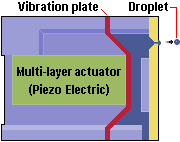Epson's proprietary inkjet technology uses a piezo crystal at the back of the ink reservoir. This is rather like a loudspeaker cone - it flexes when an electric current flows through it. So, whenever a dot is required, a current is applied to the piezo element, the element flexes and in so doing forces a drop of ink out of the nozzle.
There are several advantages to the piezo method. The process allows more control over the shape and size of ink droplet release. The tiny fluctuations in the crystal allow for smaller droplet sizes and hence higher nozzle density. Also, unlike with thermal technology, the ink does not have to be heated and cooled between each cycle. This saves time, and the ink itself is tailored more for its absorption properties than its ability to withstand high temperatures. This allows more freedom for developing new chemical properties in inks.
Epson's latest mainstream inkjets have black print-heads with 128 nozzles and colour (CMY) print-heads with 192 nozzles (64 for each colour), addressing a native resolution of 720 by 720dpi. Because the piezo process can deliver small and perfectly formed dots with high accuracy, Epson is able to offer an enhanced resolution of 1440 by 720dpi - although this is achieved by the print-head making two passes, with a consequent reduction in print speed. The tailored inks Epson has developed for use with its piezo technology are solvent-based and extremely quick-drying. They penetrate the paper and maintain their shape rather than spreading out on the surface and causing dots to interact with one another. The result is extremely good print quality, especially on coated or glossy paper.




